
Grappling is a fighting technique based on throws, trips, sweeps, clinch fighting, ground fighting and submission holds.

Kickboxing is a full-contact hybrid martial art and boxing type based on punching and kicking. Kickboxing originated in the 1950s to 1970s. The fight takes place in a boxing ring, normally with boxing gloves, mouth guards, shorts, and bare feet to favor the use of kicks. Kickboxing is practiced for self-defense, general fitness, or for competition. Some styles of kickboxing include: Full contact karate, Muay Thai, Japanese kickboxing, Lethwei, Sanda, and Savate.

Pankration was an unarmed combat sport introduced into the Greek Olympic Games in 648 BC. The athletes used boxing and wrestling techniques but also others, such as kicking, holds, joint-locks, and chokes on the ground, making it similar to modern mixed martial arts. The term comes from the Greek παγκράτιον, meaning 'all of power', from πᾶν (pan) 'all' and κράτος (kratos) 'strength, might, power'.
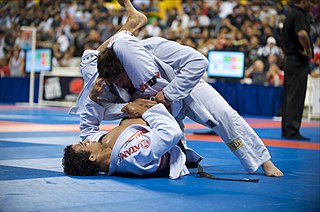
Brazilian jiu-jitsu is a self-defence martial art and combat sport based on grappling, ground fighting, and submission holds. BJJ focuses on taking ones opponent down to the ground, gaining a dominant position, and using a number of techniques to force them into submission via joint locks or chokeholds.
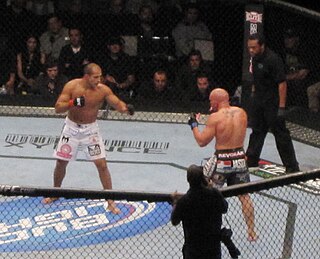
Mixed Martial Arts (MMA) is a full-contact combat sport based on striking, grappling and ground fighting, incorporating techniques from various combat sports from around the world. The first documented use of the term mixed martial arts was in a review of UFC 1 by television critic Howard Rosenberg in 1993.

A strike is a directed, forceful physical attack with either a part of the human body or with a handheld object, intended to cause blunt or penetrating trauma upon an opponent.
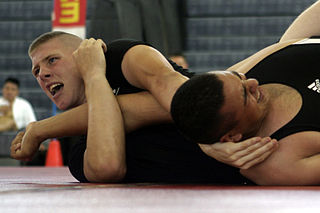
Submission wrestling, also known as submission grappling, submission fighting or simply grappling, is a competitive martial art and combat sport that focuses on ground fighting and submission techniques. It is a hybrid discipline that incorporates elements of various grappling arts such as various wrestling styles, judo, and Brazilian jiu-jitsu. Submission wrestling is practiced both as a competitive sport and as a training method for self-defence and mixed martial arts (MMA).
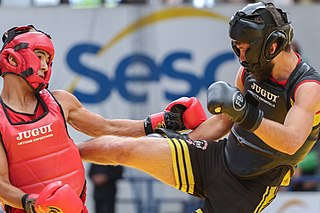
Sanda, formerly Sanshou, is the official Chinese boxing full-contact combat sport. Sanda is a fighting system which was originally developed by the Chinese military based upon the study and practices of traditional Chinese martial arts and modern combat fighting techniques; it combines boxing and full-contact kickboxing, which includes close range and rapid successive punches and kicks, with wrestling, takedowns, throws, sweeps, kick catches, and in some competitions, even elbow and knee strikes.

Sambo is a martial art with Soviet origins, an internationally practised combat sport, and a recognized style of amateur wrestling included by UWW in the World Wrestling Championships along with Graeco-Roman wrestling and freestyle wrestling.
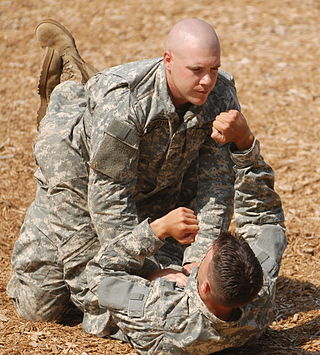
The guard is a ground grappling position in which one combatant has their back to the ground while attempting to control the other combatant using their legs. In pure grappling combat sports, the guard is considered an advantageous position, because the bottom combatant can attack with various joint locks and chokeholds, while the top combatant's priority is the transition into a more dominant position, a process known as passing the guard. In the sport of mixed martial arts, as well as hand-to-hand combat in general, it is possible to effectively strike from the top in the guard, even though the bottom combatant exerts some control. There are various types of guard, with their own advantages and disadvantages.

The mount, or mounted position, is a dominant ground grappling position, where one combatant sits on the other combatants torso with the face pointing towards the opponent's head. This is a favorable position for the top combatant in several ways. The top combatant can generate considerable momentum for strikes to the head of the opponent, while the bottom combatant is restricted by the ground and by the combatant on top. Other advantages include various chokeholds and joint locks that can be applied from the top. The bottom combatant will usually look to sweep the opponent or transition into a better position such as the guard.
A leglock is a joint lock that is directed at joints of the leg such as the ankle, knee or hip joint. A leglock which is directed at joints in the foot is sometimes referred to as a foot lock and a lock at the hip as a hip lock. Leglocks are featured, with various levels of restrictions, in combat sports and martial arts such as Sambo, Brazilian Jiu-Jitsu, catch wrestling, mixed martial arts, Shootwrestling and submission wrestling, but are banned in some sports featuring joint locks such as judo. The technique has been seen across a wide range of different combat sports and is reportedly over 2,500 years old, having been seen in the lost art of Pankration in the original Olympic Games.

In martial arts and combat sports, stand-up fighting is hand-to-hand combat between opponents in a standing position, as distinguished from ground fighting. Clinch fighting is stand-up grappling. Fighters employ striking, including striking combinations, using either body parts or mêlée weapons, to incapacitate or injure the opponent. Combatants use blocking techniques to block the opponent's attacks.

Clinch fighting or trapping is the part of stand-up fighting where the combatants are grappling in a clinch, typically using clinch holds. Clinching the opponent can be used to eliminate the opponent's effective usage of some kicks, punches, and melee weapons. The clinch can also be used as a medium to switch from stand-up fighting to ground fighting by using takedowns, throws or sweeps.

A grappling hold, commonly referred to simply as a hold that in Japanese is referred to as katame-waza, is any specific grappling, wrestling, judo, or other martial art grip that is applied to an opponent. Grappling holds are used principally to control the opponent and to advance in points or positioning. The holds may be categorized by their function, such as clinching, pinning, or submission, while others can be classified by their anatomical effect: chokehold, headlock, joint-lock, or compression lock. Multiple categories may be appropriate for some of these holds.

A grappling position refers to the positioning and holds of combatants engaged in grappling. Combatants are said to be in a neutral position if neither is in a more favourable position. If one party has a clear advantage such as in the mount they are said to be in a "dominant position". Conversely, the other party is considered to be in an inferior position, usually called "on the bottom", but in this case sometimes called the "under mount".
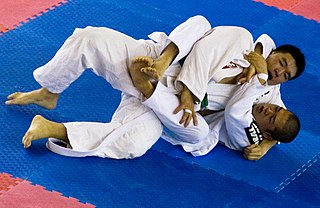
In combat sports, a spinal lock is a multiple joint lock applied to the spinal column, which is performed by forcing the spine beyond its normal ranges of motion. This is typically done by bending or twisting the head or upper body into abnormal positions. Commonly, spinal locks might strain the spinal musculature or result in a mild spinal sprain, while a forcefully and/or suddenly applied spinal lock may cause severe ligament damage or damage to the vertebrae, and possibly result in serious spinal cord injury, stroke, or death. Spinal locks and cervical locks are forbidden in IBJJF Brazilian jiu-jitsu competitions, amateur mixed martial arts (MMA), multiple forms of no Gi jiu-jitsu, judo, and other martial arts. However, professional MMA and some Brazilian jiu-jitsu competitions do permit spinal locks and, particularly, neck cranks, and such moves are trained in various MMA and Brazilian jiu-jitsu schools.

Half guard is a defensive ground grappling position where one combatant is lying on the other, with the bottom combatant having one leg entangled. Sometimes the bottom combatant is said to be in half guard, while the top combatant is in a half mount. In wrestling and catch wrestling half mount is called Turk ride. The half guard is the position that is in between a full guard and side control or full mount. The combatant on top will try to untangle the leg and pass to obtain side control or mount, while the bottom combatant will try to transition into a full guard or alternatively attempt a sweep or submission. The half guard may favour the combatant on top or the guard player, depending on the many details of the position such as body positioning and grips.

Jujutsu, also known as jiu-jitsu and ju-jitsu, is a family of Japanese martial arts and a system of close combat that can be used in a defensive or offensive manner to kill or subdue one or more weaponless or armed and armored opponents. It was coined by Hisamori Tenenuchi when he officially established the first school of jiu-jitsu in Japan. A subset of techniques from certain styles of jujutsu were used to develop many modern martial arts and combat sports, such as judo, aikido, sambo, ARB, Brazilian jiu-jitsu, and mixed martial arts.
The Federation of Mixed Impact Martial Arts R-1 is a promotional organization aimed at mixed martial arts "R-1" development and popularization in Russia. The R-1 Federation unites various aspects of martial arts. R-1 rules are based on research into preferences of tournament participants and spectators. The rules are intended to guarantee maximum entertainment. A related product called Combat Time R-1 emerged on the world professional sports arena.





























